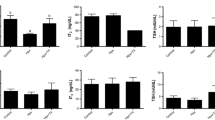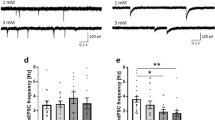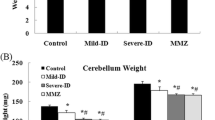Abstract
Gestational hypothyroxinemia, characterized by low levels of maternal thyroxine (T4) during gestation, is closely associated with cognitive impairment in offspring. Studies in animal models have shown that this condition alters neuronal glutamatergic synapses in the hippocampus. Given that astrocytes critically contribute to the establishment and functioning of synapses, the aim of this study was to determine the effects of gestational hypothyroxinemia on the capacity of astrocytes to regulate glutamatergic synapses. In an in vitro co-culture model of astrocytes and hippocampal neurons, gestational hypothyroxinemia profoundly affected the synaptic patterns of GluN1 and CD3ζ in an astrocyte-dependent manner. These effects were associated with impaired plasticity that was dependent on both neuronal and astrocyte contributions. These results highlight the importance of neuron-astrocyte interplay in the deleterious effects of gestational hypothyroxinemia and the timely diagnosis and treatment of this condition during gestation to ensure proper central nervous system development in offspring.






Similar content being viewed by others
References
Delahunty C, Simpson J, Richard K, Coughtrie M, Williams F, Murphy N, Matthews T, Visser T et al (2001) Transient hypothyroxinaemia in preterm infants. Dev Med Child Neurol Suppl 86:26–27
Williams FL, Visser TJ, Hume R (2006) Transient hypothyroxinaemia in preterm infants. Early Human Dev 82(12):797–802. doi:10.1016/j.earlhumdev.2006.09.007
Wei W, Wang Y, Dong J, Min H, Song B, Teng W, Xi Q, Chen J (2013) Developmental hypothyroxinaemia induced by maternal mild iodine deficiency delays hippocampal axonal growth in the rat offspring. J Neuroendocrinol 25(9):852–862. doi:10.1111/jne.12058
Morreale de Escobar G, Obregon MJ, Escobar del Rey F (2000) Is neuropsychological development related to maternal hypothyroidism or to maternal hypothyroxinemia? J Clin Endocrinol Metab 85(11):3975–3987. doi:10.1210/jcem.85.11.6961
Morreale de Escobar G, Escobar del Rey F (1999) Maternal thyroid deficiency during pregnancy and subsequent neuropsychological development of the child. N Engl J Med 341(26):2015–2016, author reply 2017
Pop VJ, Brouwers EP, Vader HL, Vulsma T, van Baar AL, de Vijlder JJ (2003) Maternal hypothyroxinaemia during early pregnancy and subsequent child development: a 3-year follow-up study. Clin Endocrinol 59(3):282–288
Pop VJ, Brouwers EP, Wijnen H, Oei G, Essed GG, Vader HL (2004) Low concentrations of maternal thyroxin during early gestation: a risk factor of breech presentation? BJOG : Int Jf Obstet Gynaecol 111(9):925–930. doi:10.1111/j.1471-0528.2004.00213.x
Pop VJ, Vulsma T (2005) Maternal hypothyroxinaemia during (early) gestation. Lancet 365(9471):1604–1606. doi:10.1016/S0140-6736(05)66489-6
Kooistra L, Crawford S, van Baar AL, Brouwers EP, Pop VJ (2006) Neonatal effects of maternal hypothyroxinemia during early pregnancy. Pediatr 117(1):161–167. doi:10.1542/peds.2005-0227
Williams F, Hume R (2011) The measurement, definition, aetiology and clinical consequences of neonatal transient hypothyroxinaemia. Ann Clin Biochem 48(Pt 1):7–22. doi:10.1258/acb.2010.010174
Suarez-Rodriguez M, Azcona-San Julian C, Alzina de Aguilar V (2012) Hypothyroxinemia during pregnancy: the effect on neurodevelopment in the child. Int J Dev Neurosci: Off J IntSoc Dev Neurosci 30(6):435–438. doi:10.1016/j.ijdevneu.2012.07.004
Wang Y, Dong J, Wei W, Song B, Min H, Yu Y, Lei X, Zhao M et al (2014) Developmental hypothyroxinemia and hypothyroidism reduce proliferation of cerebellar granule neuron precursors in rat offspring by downregulation of the sonic hedgehog signaling pathway. Mol Neurobiol 49(3):1143–1152. doi:10.1007/s12035-013-8587-3
Auso E, Lavado-Autric R, Cuevas E, Del Rey FE, Morreale De Escobar G, Berbel P (2004) A moderate and transient deficiency of maternal thyroid function at the beginning of fetal neocorticogenesis alters neuronal migration. Endocrinology 145(9):4037–4047. doi:10.1210/en.2004-0274
Lavado-Autric R, Auso E, Garcia-Velasco JV, Arufe Mdel C, Escobar del Rey F, Berbel P, Morreale de Escobar G (2003) Early maternal hypothyroxinemia alters histogenesis and cerebral cortex cytoarchitecture of the progeny. J Clin Investig 111(7):1073–1082. doi:10.1172/JCI16262
Opazo MC, Gianini A, Pancetti F, Azkcona G, Alarcon L, Lizana R, Noches V, Gonzalez PA et al (2008) Maternal hypothyroxinemia impairs spatial learning and synaptic nature and function in the offspring. Endocrinology 149(10):5097–5106. doi:10.1210/en.2008-0560
Wang Y, Wei W, Dong J, Song B, Min H, Teng W, Chen J (2013) Neurotoxicity of developmental hypothyroxinemia and hypothyroidism in rats: impairments of long-term potentiation are mediated by phosphatidylinositol 3-kinase signaling pathway. Toxicol Appl Pharmacol 271(2):257–265. doi:10.1016/j.taap.2013.04.034
van Spronsen M, Hoogenraad CC (2010) Synapse pathology in psychiatric and neurologic disease. Curr Neurol Neurosci Reports 10(3):207–214. doi:10.1007/s11910-010-0104-8
Willard SS, Koochekpour S (2013) Glutamate, glutamate receptors, and downstream signaling pathways. Int J Biol Sci 9(9):948–959. doi:10.7150/ijbs.6426
McAllister AK (2007) Dynamic aspects of CNS synapse formation. Annu Rev Neurosci 30:425–450. doi:10.1146/annurev.neuro.29.051605.112830
Ronan JL, Wu W, Crabtree GR (2013) From neural development to cognition: unexpected roles for chromatin. Nat Rev Genet 14(5):347–359. doi:10.1038/nrg3413
Pfrieger FW (2010) Role of glial cells in the formation and maintenance of synapses. Brain Res Rev 63(1–2):39–46. doi:10.1016/j.brainresrev.2009.11.002
Ullian EM, Sapperstein SK, Christopherson KS, Barres BA (2001) Control of synapse number by glia. Science 291(5504):657–661. doi:10.1126/science.291.5504.657
Ullian EM, Christopherson KS, Barres BA (2004) Role for glia in synaptogenesis. Glia 47(3):209–216. doi:10.1002/glia.20082
Ehlers MD (2005) Synapse formation: astrocytes spout off. Curr Biol: CB 15(4):R134–R137. doi:10.1016/j.cub.2005.02.013
Faissner A, Pyka M, Geissler M, Sobik T, Frischknecht R, Gundelfinger ED, Seidenbecher C (2010) Contributions of astrocytes to synapse formation and maturation—potential functions of the perisynaptic extracellular matrix. Brain Res Rev 63(1–2):26–38. doi:10.1016/j.brainresrev.2010.01.001
Perea G, Navarrete M, Araque A (2009) Tripartite synapses: astrocytes process and control synaptic information. Trends Neurosci 32(8):421–431. doi:10.1016/j.tins.2009.05.001
Navarrete M, Perea G, Fernandez de Sevilla D, Gomez-Gonzalo M, Nunez A, Martin ED, Araque A (2012) Astrocytes mediate in vivo cholinergic-induced synaptic plasticity. PLoS Biol 10(2):e1001259. doi:10.1371/journal.pbio.1001259
Perea G, Araque A (2010) GLIA modulates synaptic transmission. Brain Res Rev 63(1–2):93–102. doi:10.1016/j.brainresrev.2009.10.005
Perea G, Araque A (2005) Glial calcium signaling and neuron-glia communication. Cell Calcium 38(3–4):375–382. doi:10.1016/j.ceca.2005.06.015
Araque A, Perea G (2004) Glial modulation of synaptic transmission in culture. Glia 47(3):241–248. doi:10.1002/glia.20026
Christopherson KS, Ullian EM, Stokes CC, Mullowney CE, Hell JW, Agah A, Lawler J, Mosher DF et al (2005) Thrombospondins are astrocyte-secreted proteins that promote CNS synaptogenesis. Cell 120(3):421–433. doi:10.1016/j.cell.2004.12.020
Kucukdereli H, Allen NJ, Lee AT, Feng A, Ozlu MI, Conatser LM, Chakraborty C, Workman G et al (2011) Control of excitatory CNS synaptogenesis by astrocyte-secreted proteins Hevin and SPARC. Proc Natl Acad Sci U S A 108(32):E440–E449. doi:10.1073/pnas.1104977108
Allen NJ, Bennett ML, Foo LC, Wang GX, Chakraborty C, Smith SJ, Barres BA (2012) Astrocyte glypicans 4 and 6 promote formation of excitatory synapses via GluA1 AMPA receptors. Nature 486(7403):410–414. doi:10.1038/nature11059
Jones EV, Bernardinelli Y, Tse YC, Chierzi S, Wong TP, Murai KK (2011) Astrocytes control glutamate receptor levels at developing synapses through SPARC-beta-integrin interactions. J Neurosci: Off J Soc Neurosci 31(11):4154–4165. doi:10.1523/JNEUROSCI.4757-10.2011
Bredt DS, Nicoll RA (2003) AMPA receptor trafficking at excitatory synapses. Neuron 40(2):361–379
Jayakumar AR, Tong XY, Curtis KM, Ruiz-Cordero R, Shamaladevi N, Abuzamel M, Johnstone J, Gaidosh G et al (2014) Decreased astrocytic thrombospondin-1 secretion after chronic ammonia treatment reduces the level of synaptic proteins: in vitro and in vivo studies. J Neurochem 131(3):333–347. doi:10.1111/jnc.12810
Jacobs S, Doering LC (2010) Astrocytes prevent abnormal neuronal development in the fragile x mouse. J Neurosci: Off J Soc Neurosci 30(12):4508–4514. doi:10.1523/JNEUROSCI.5027-09.2010
Sloan SA, Barres BA (2014) Mechanisms of astrocyte development and their contributions to neurodevelopmental disorders. Curr Opin Neurobiol 27:75–81. doi:10.1016/j.conb.2014.03.005
Ballas N, Lioy DT, Grunseich C, Mandel G (2009) Non-cell autonomous influence of MeCP2-deficient glia on neuronal dendritic morphology. Nat Neurosci 12(3):311–317. doi:10.1038/nn.2275
Jacobs S, Nathwani M, Doering LC (2010) Fragile X astrocytes induce developmental delays in dendrite maturation and synaptic protein expression. BMC Neurosci 11:132. doi:10.1186/1471-2202-11-132
Angibaud J, Louveau A, Baudouin SJ, Nerriere-Daguin V, Evain S, Bonnamain V, Hulin P, Csaba Z et al (2011) The immune molecule CD3zeta and its downstream effectors ZAP-70/Syk mediate ephrin signaling in neurons to regulate early neuritogenesis. J Neurochem 119(4):708–722. doi:10.1111/j.1471-4159.2011.07469.x
Louveau A, Angibaud J, Haspot F, Opazo MC, Thinard R, Thepenier V, Baudouin SJ, Lescaudron L et al (2013) Impaired spatial memory in mice lacking CD3zeta is associated with altered NMDA and AMPA receptors signaling independent of T-cell deficiency. J Neurosci: Off J Soc Neurosci 33(47):18672–18685. doi:10.1523/JNEUROSCI.3028-13.2013
Bykhovskaia M (2011) Synapsin regulation of vesicle organization and functional pools. Semin Cell Dev Biol 22(4):387–392. doi:10.1016/j.semcdb.2011.07.003
Han K, Kim E (2008) Synaptic adhesion molecules and PSD-95. Prog Neurobiol 84(3):263–283. doi:10.1016/j.pneurobio.2007.10.011
Kim E, Sheng M (2004) PDZ domain proteins of synapses. Nat Rev Neurosci 5(10):771–781. doi:10.1038/nrn1517
Wenthold RJ, Prybylowski K, Standley S, Sans N, Petralia RS (2003) Trafficking of NMDA receptors. Annu Rev Pharmacol Toxicol 43:335–358. doi:10.1146/annurev.pharmtox.43.100901.135803
Lau CG, Zukin RS (2007) NMDA receptor trafficking in synaptic plasticity and neuropsychiatric disorders. Nat Rev Neurosci 8(6):413–426. doi:10.1038/nrn2153
Lu W, Man H, Ju W, Trimble WS, MacDonald JF, Wang YT (2001) Activation of synaptic NMDA receptors induces membrane insertion of new AMPA receptors and LTP in cultured hippocampal neurons. Neuron 29(1):243–254
Liao D, Scannevin RH, Huganir R (2001) Activation of silent synapses by rapid activity-dependent synaptic recruitment of AMPA receptors. J Neurosci: Off J Soc Neurosci 21(16):6008–6017
Oh MC, Derkach VA (2005) Dominant role of the GluR2 subunit in regulation of AMPA receptors by CaMKII. Nat Neurosci 8(7):853–854. doi:10.1038/nn1476
Sharma K, Fong DK, Craig AM (2006) Postsynaptic protein mobility in dendritic spines: long-term regulation by synaptic NMDA receptor activation. Mol Cell Neurosci 31(4):702–712. doi:10.1016/j.mcn.2006.01.010
Paoletti P, Bellone C, Zhou Q (2013) NMDA receptor subunit diversity: impact on receptor properties, synaptic plasticity and disease. Nat Rev Neurosci 14(6):383–400. doi:10.1038/nrn3504
McIlhinney RA, Philipps E, Le Bourdelles B, Grimwood S, Wafford K, Sandhu S, Whiting P (2003) Assembly of N-methyl-D-aspartate (NMDA) receptors. Biochem Soc Trans 31(Pt 4):865–868
Pochwat B, Szewczyk B, Sowa-Kucma M, Siwek A, Doboszewska U, Piekoszewski W, Gruca P, Papp M et al (2014) Antidepressant-like activity of magnesium in the chronic mild stress model in rats: alterations in the NMDA receptor subunits. Int J Neuropsychopharm 17(3):393–405. doi:10.1017/S1461145713001089
Lisman J, Yasuda R, Raghavachari S (2012) Mechanisms of CaMKII action in long-term potentiation. Nat Rev Neurosci 13(3):169–182. doi:10.1038/nrn3192
Groth RD, Lindskog M, Thiagarajan TC, Li L, Tsien RW (2011) Beta Ca2+/CaM-dependent kinase type II triggers upregulation of GluA1 to coordinate adaptation to synaptic inactivity in hippocampal neurons. Proc Natl Acad Sci U S A 108(2):828–833. doi:10.1073/pnas.1018022108
Sanhueza M, Fernandez-Villalobos G, Stein IS, Kasumova G, Zhang P, Bayer KU, Otmakhov N, Hell JW et al (2011) Role of the CaMKII/NMDA receptor complex in the maintenance of synaptic strength. J Neurosci: Off J Soc Neurosci 31(25):9170–9178. doi:10.1523/JNEUROSCI.1250-11.2011
Molnar E (2011) Long-term potentiation in cultured hippocampal neurons. Semin Cell Dev Biol 22(5):506–513. doi:10.1016/j.semcdb.2011.07.017
Pavlov I, Lauri S, Taira T, Rauvala H (2004) The role of ECM molecules in activity-dependent synaptic development and plasticity. Birth Defects Res Part C Embryo Today: Rev 72(1):12–24. doi:10.1002/bdrc.20001
Farwell AP, Dubord-Tomasetti SA (1999) Thyroid hormone regulates the extracellular organization of laminin on astrocytes. Endocrinology 140(11):5014–5021. doi:10.1210/endo.140.11.7114
Mendes-de-Aguiar CB, Alchini R, Zucco JK, Costa-Silva B, Decker H, Alvarez-Silva M, Tasca CI, Trentin AG (2010) Impaired astrocytic extracellular matrix distribution under congenital hypothyroidism affects neuronal development in vitro. J Neurosci Res 88(15):3350–3360. doi:10.1002/jnr.22481
Xu J, Xiao N, Xia J (2010) Thrombospondin 1 accelerates synaptogenesis in hippocampal neurons through neuroligin 1. Nat Neurosci 13(1):22–24. doi:10.1038/nn.2459
Patel VA, Hill DJ, Eggo MC, Sheppard MC, Becks GP, Logan A (1996) Changes in the immunohistochemical localisation of fibroblast growth factor-2, transforming growth factor-beta 1 and thrombospondin-1 are associated with early angiogenic events in the hyperplastic rat thyroid. J Endocrinol 148(3):485–499
Calloni GW, Alvarez-Silva M, Vituri C, Trentin AG (2001) Thyroid hormone deficiency alters extracellular matrix protein expression in rat brain. Brain Res Dev Brain Res 126(1):121–124
Diniz LP, Almeida JC, Tortelli V, Vargas Lopes C, Setti-Perdigao P, Stipursky J, Kahn SA, Romao LF et al (2012) Astrocyte-induced synaptogenesis is mediated by transforming growth factor beta signaling through modulation of D-serine levels in cerebral cortex neurons. J Biol Chem 287(49):41432–41445. doi:10.1074/jbc.M112.380824
Heupel K, Sargsyan V, Plomp JJ, Rickmann M, Varoqueaux F, Zhang W, Krieglstein K (2008) Loss of transforming growth factor-beta 2 leads to impairment of central synapse function. Neural Dev 3:25. doi:10.1186/1749-8104-3-25
Akinci B, Comlekci A, Yener S, Bayraktar F, Demir T, Ozcan MA, Yuksel F, Yesil S (2008) Hashimoto's thyroiditis, but not treatment of hypothyroidism, is associated with altered TGF-beta1 levels. Arch Med Res 39(4):397–401. doi:10.1016/j.arcmed.2007.12.001
Patel J, Landers K, Li H, Mortimer RH, Richard K (2011) Delivery of maternal thyroid hormones to the fetus. Trends Endocrinol Metabolism: TEM 22(5):164–170. doi:10.1016/j.tem.2011.02.002
Leonard JL (2008) Non-genomic actions of thyroid hormone in brain development. Steroids 73(9–10):1008–1012. doi:10.1016/j.steroids.2007.12.016
Davis PJ, Davis FB, Cody V (2005) Membrane receptors mediating thyroid hormone action. Trends Endocrinol Metab: TEM 16(9):429–435. doi:10.1016/j.tem.2005.09.007
Trentin AG (2006) Thyroid hormone and astrocyte morphogenesis. J Endocrinol 189(2):189–197. doi:10.1677/joe.1.06680
Shi Y, Ethell IM (2006) Integrins control dendritic spine plasticity in hippocampal neurons through NMDA receptor and Ca2+/calmodulin-dependent protein kinase II-mediated actin reorganization. J Neurosci: Off J Soc Neurosci 26(6):1813–1822. doi:10.1523/JNEUROSCI.4091-05.2006
Scapin S, Leoni S, Spagnuolo S, Gnocchi D, De Vito P, Luly P, Pedersen JZ, Incerpi S (2010) Short-term effects of thyroid hormones during development: focus on signal transduction. Steroids 75(8–9):576–584. doi:10.1016/j.steroids.2009.10.013
Hsu JH, Brent GA (1998) Thyroid hormone receptor gene knockouts. Trends Endocrinol Metab: TEM 9(3):103–112
Dong H, You SH, Williams A, Wade MG, Yauk CL, Thomas Zoeller R (2015) Transient maternal hypothyroxinemia potentiates the transcriptional response to exogenous thyroid hormone in the fetal cerebral cortex before the onset of fetal thyroid function: a messenger and microRNA profiling study. Cereb Cortex 25(7):1735–1745. doi:10.1093/cercor/bht364
Acknowledgments
This study was supported by funding awarded by the Fondo Nacional de Desarrollo Científico y Tecnológico de Chile (FONDECYT Projects 1130996, 1140010, 1110604, 1100971, 1131012, and 1110397), the Millennium Institute on Immunology and Immunotherapy P09/016-F, and the La Région Pays De La Loire through the “Nouvelles Equipes-nouvelles thématiques” Grant. AMK is a Chaire De La Région Pays De La Loire, Chercheur Étranger D'excellence, France. Additional funding was also received from the Comité de Evaluación y Orientación de la Cooperación Científica con Chile del Gobierno de Francia (ECOS)-Comisión Nacional de Investigación Científica y Tecnológica (CONICYT) Grant C11S03 through the CONICYT-Instituto Nacional de Salud y de Investigación Médica de Francia (INSERM) Program, the Universidad Andrés Bello (UNAB) Proyecto Inicio DI-31/11R, and the Proyecto Nucleo UNAB DI-471-15/N.
Author information
Authors and Affiliations
Corresponding authors
Electronic supplementary material
Below is the link to the electronic supplementary material.
Supplementary Figure 1
Experimental timeline and groups. Scheme of the experimental timeline. Red and blue rectangles = pregnant rats; MMI = methimazole-treated rats; IF = immunofluorescence; C = control group; H = hypothyroxinemia group; DIV = days in vitro; CA = astrocytes derived from control-gestated rats; HA = astrocytes derived from hypothyroxinemia-gestated rats; CN = neurons derived from control-gestated rats; and HN = neurons derived from hypothyroxinemia-gestated rats. CACN, CAHN, HACN, and HAHN represent the four types of co-cultures analyzed. (GIF 43 kb)
Supplementary Figure 2
GFAP content and distribution remains normal in hypothyroxinemia-derived astrocytes. (a) Representative photographs of control-derived astrocytes (CA) and (b) hypothyroxinemia-derived astrocytes (HA) showing glial fibrillary acidic protein (GFAP) distribution. (c) Quantification of GFAP distribution. The results are shown as the mean ± SEM of n = 3. No significant differences were found (p = not statically significant). Scale bar = 30 μm. (d) Representative Western blots for GFAP of CA and HA. (e) Quantification of GFAP content. The results are shown as the mean ± SEM of n = 3. No significant differences were found (p = not statically significant) (GIF 69 kb)
Supplementary Figure 3
Full-size western blot for syn-1, PSD-95 and GluN1. Representative western blots for (a) syn-1 (90 kDa), (b) PSD-95 (95 kDa), (c) GluN1 (116 kDa), and actin (43 kDa). Protein content is visualized for four experimental groups CACN = control astrocytes, control neurons; CAHN = control astrocytes, hypothyroxinemia-derived neurons; HACN = hypothyroxinemia-derived astrocytes, control neurons; and HAHN = hypothyroxinemia-derived astrocytes, hypothyroxinemia-derived neurons (GIF 55 kb)
Supplementary Table 1
Cluster size for syn-1, PSD-95, GluN1 and CD3ζ. The size of clusters were analyzed in neurons co-cultured with astrocytes in the following four experimental groups: CACN = control astrocytes, control neurons; CAHN = control astrocytes, hypothyroxinemia-derived neurons; HACN = hypothyroxinemia-derived astrocytes, control neurons; and HAHN = hypothyroxinemia-derived astrocytes, hypothyroxinemia-derived neurons. Data are presented as the mean size (um2) ± SE. * indicates significant differences, where p < 0.05 Kruskal-Wallis with Dunn’s posttest for GluN1 and p < 0.05 one-way ANOVA with Tukey's posttest for Syn, PSD95 and CD3ζ . Experimental n are 12 for syn-1, 4 for PSD95 and 8 for both GluN1 and CD3ζ (GIF 33 kb)
Rights and permissions
About this article
Cite this article
Cisternas, P., Louveau, A., Bueno, S.M. et al. Gestational Hypothyroxinemia Affects Glutamatergic Synaptic Protein Distribution and Neuronal Plasticity Through Neuron-Astrocyte Interplay. Mol Neurobiol 53, 7158–7169 (2016). https://doi.org/10.1007/s12035-015-9609-0
Received:
Accepted:
Published:
Issue Date:
DOI: https://doi.org/10.1007/s12035-015-9609-0




